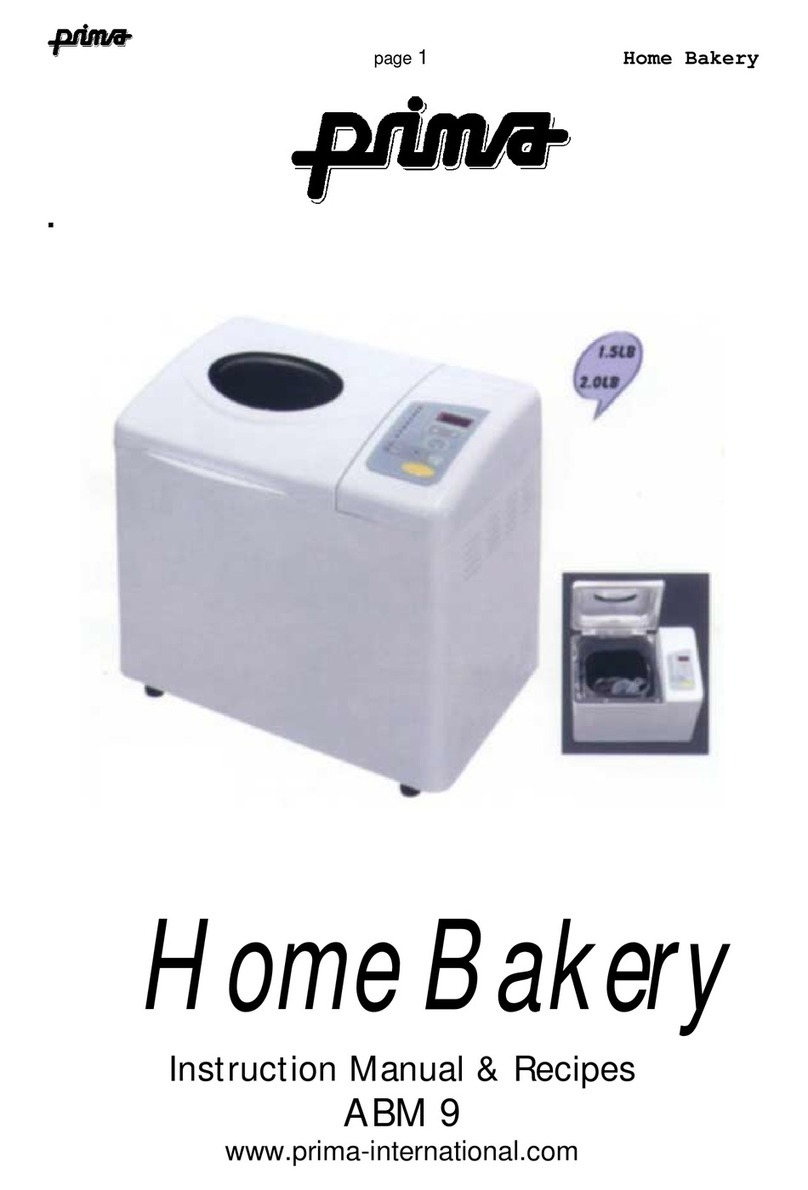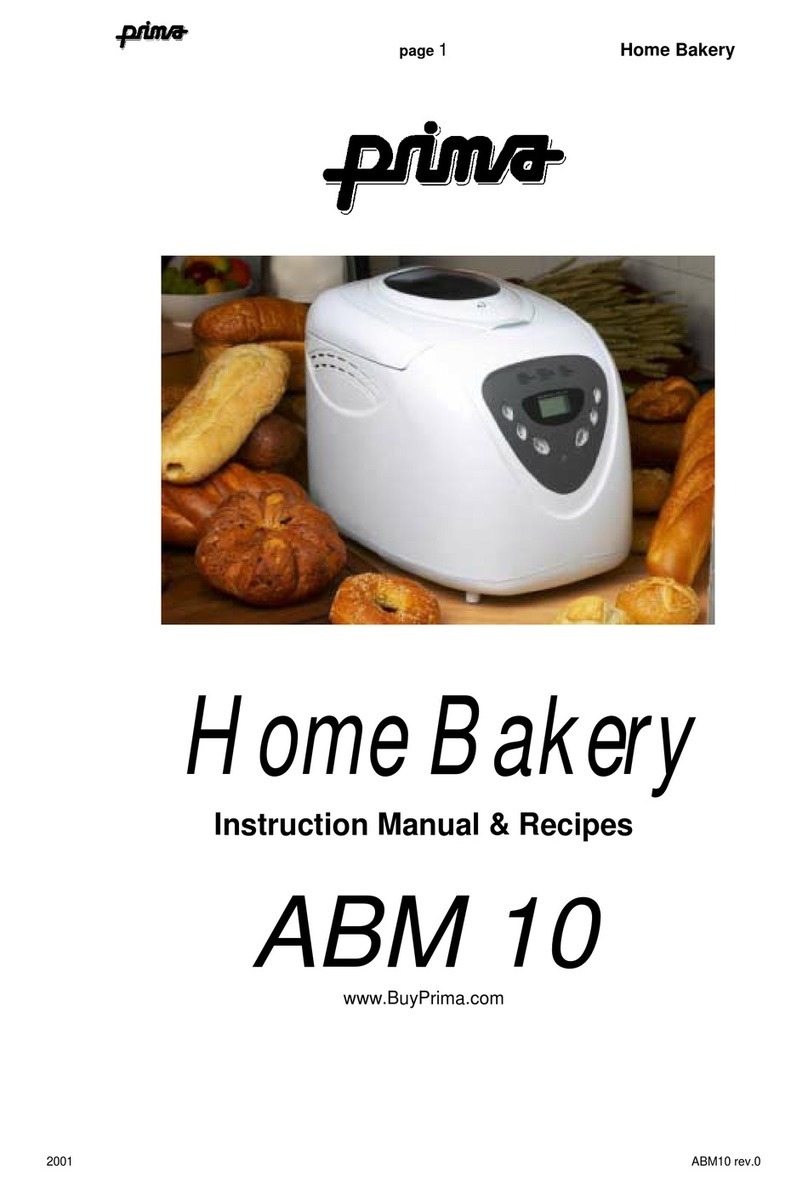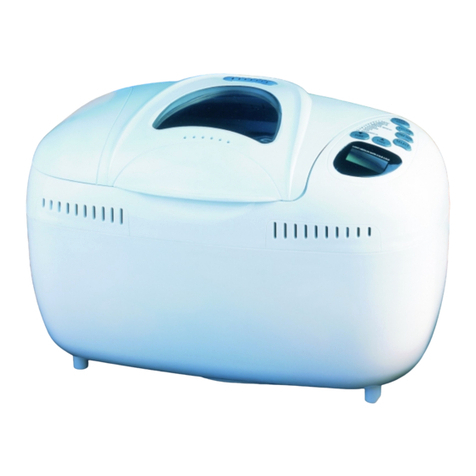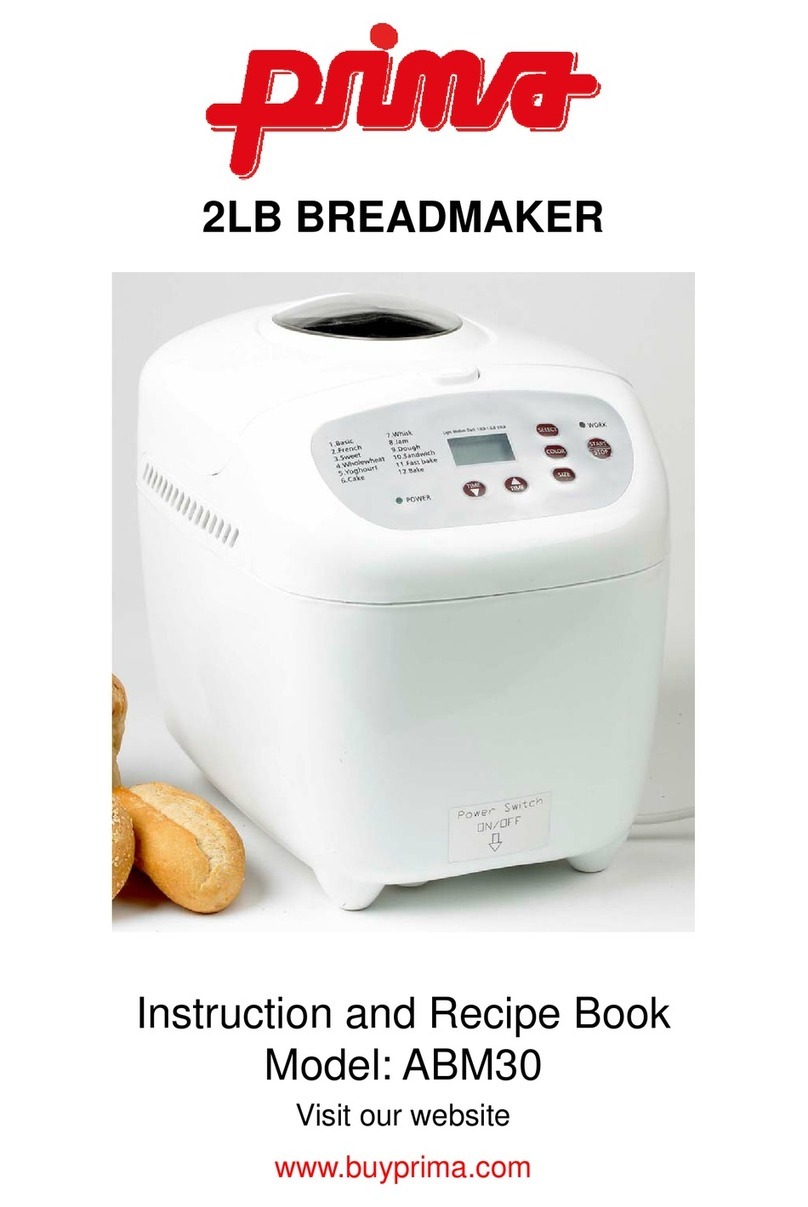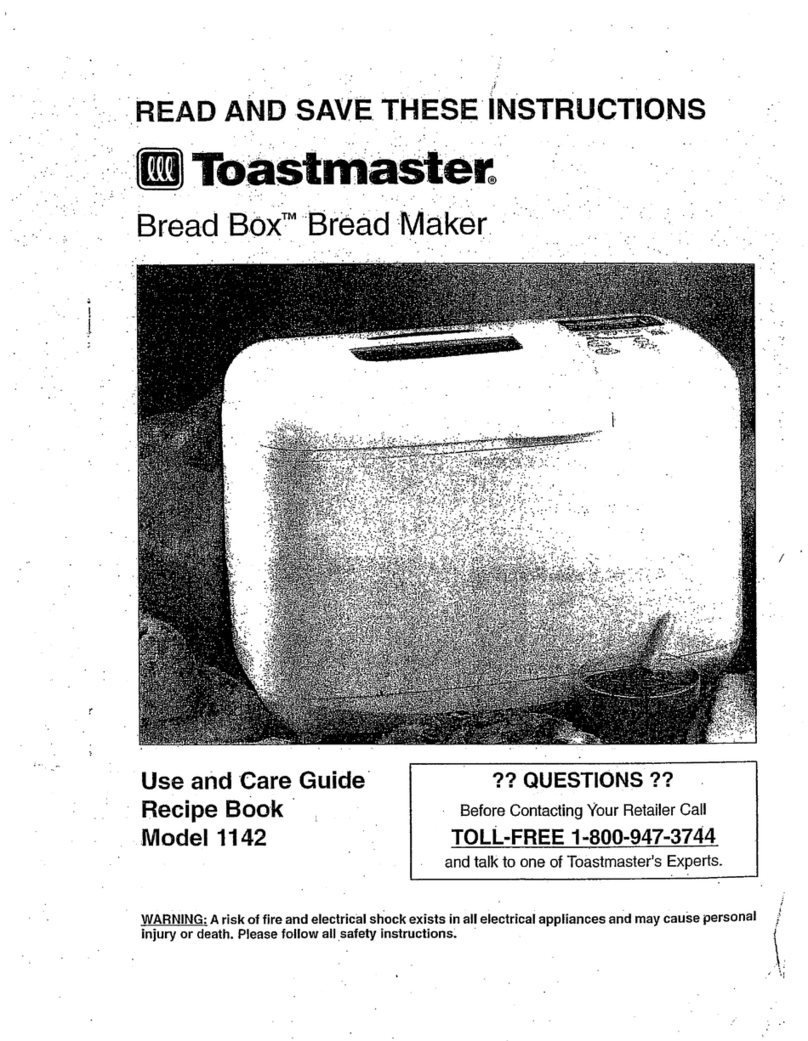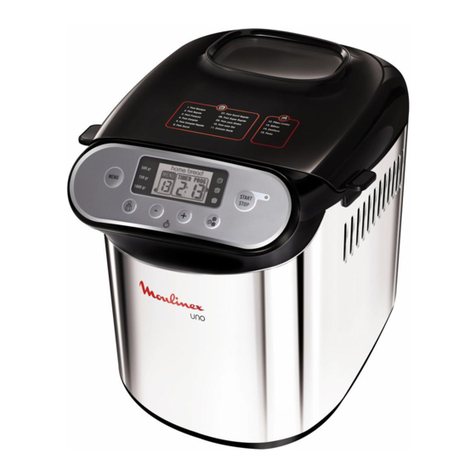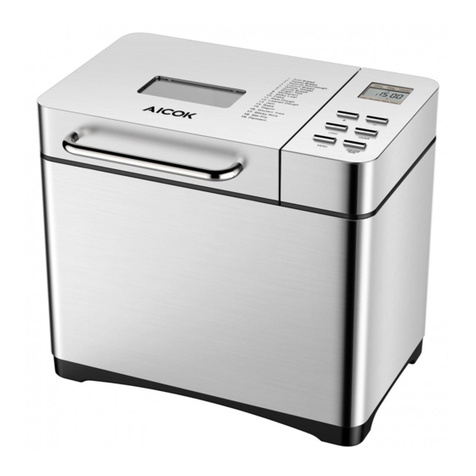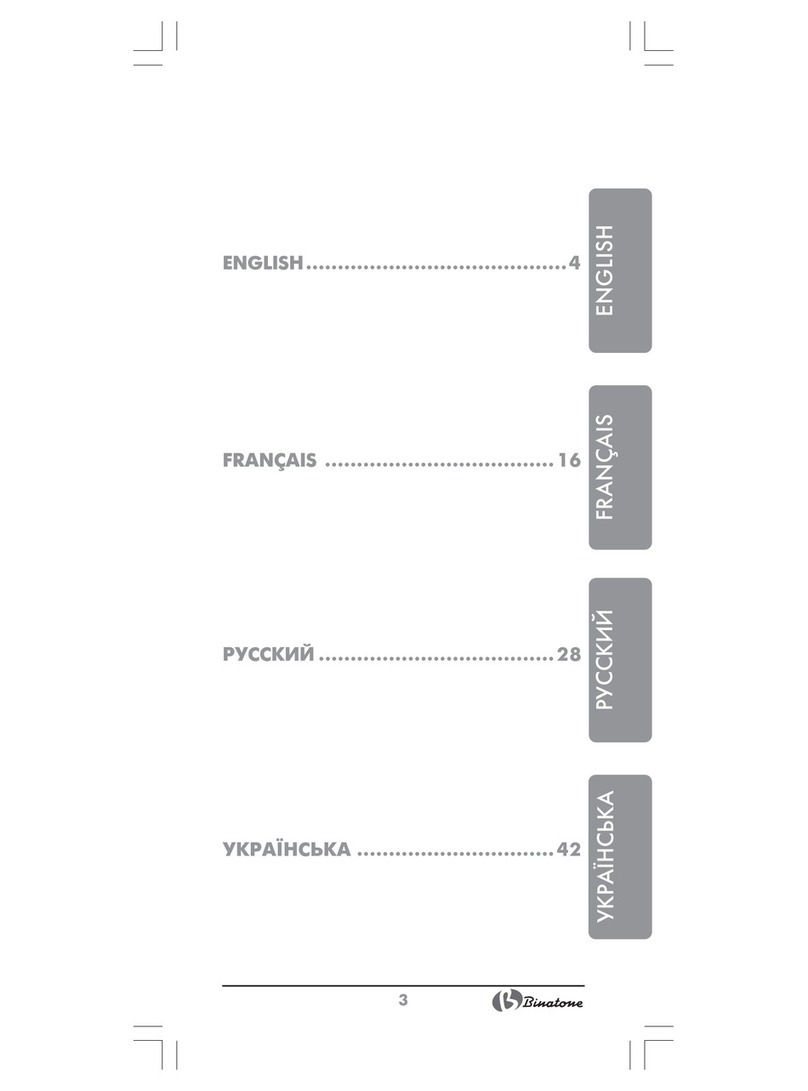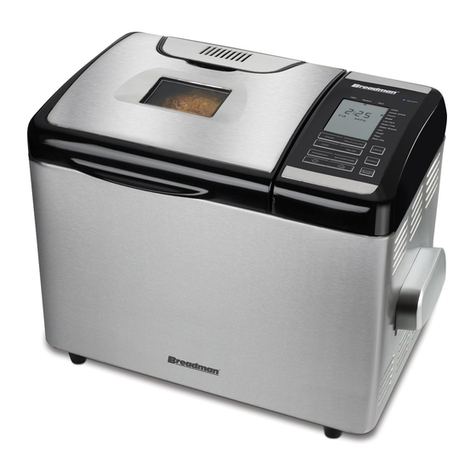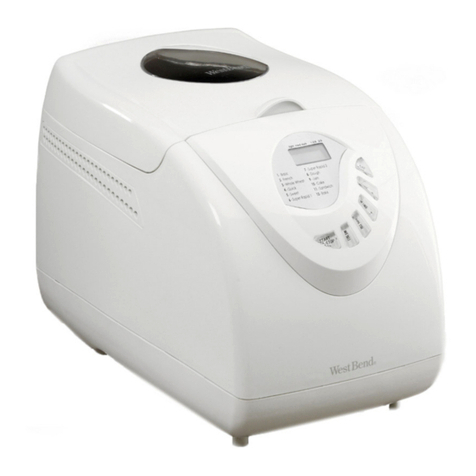Prima ABM 4 Technical specifications

Jfome (Bakgry
Instruction Manual &Recipes
ABM 4
'Visit our web site www.pnma-international.com'

*page 2ftfome 'Bakgry
'EssentiaCInformation
(PCease read these instructions
Your Prima Home Bakery is the result of Prima 's many years of
experience with bread making machines. Whether you have
never made bread before or if you have made your own bread
for years, the information in this booklet is essential if you are
to obtain the best from your machine.
There are anumber of key differences between manual bread
making and machine bread making. It is best to approach the
subject without any pre-conceived ideas or expectations.
This book has been designed to ensure that you get
outstanding results right from the first loaf you make. There
are anumber of recipes included which use all the various
programmes and functions of the machine. These recipes have
been designed to give you an instinctive feel for the machine.
This will create apattern of success that will eventually lead to
your adapting or creating your own recipes. Indeed, you will
probably find that most other recipes are variations of those
found within this book.

prim/a-
Page3y{ome Bakery
PLEASE KEEP THE BOX AND PACKAGING
THE PACKAGING IS SPECIALLY DESIGNED TO TRANSPORT THE APPLIANCE SAFELY. IF YOU
EVER NEED TO RETURN THE UNIT FOR A SERVICE IN THE FUTURE THERE IS AGOOD
CHANCE IT WILL ARRIVE DAMAGED IF ANY OTHER TYPE OF PACKAGING IS USED.
•Important safety information
Please read &retain for future reference.
Please read through all the instructions before using the breadmaker.
Be sure to use suitable mains supply 220-240V -AC
DO NOT touch hot surfaces during operation.
DO NOT allow children to operate this machine unsupervised.
NEVER place hands/fingers into the bread pan whilst the machine is in
use.
DO NOT immerse plug, cord or base in water or other liquids.
DO NOT use the breadmaker outdoors
KEEP the breadmaker at least 50mm away from walls or any other
objects when in use.
ALWAYS unplug the appliance when not in use or before cleaning.
ALWAYS use on an even surface &check that the rubber feet have a
secure grip.
DO NOT allow power cord to hang over edge of counter or work
surface.
ALWAYS use two hands when moving the machine.
CLEAN the outside of the breadmaker with adamp cloth only. The
bread pan should be cleaned after each use with mild detergent
solution, rinsed and dried thoroughly.
•IF the unit is dropped or becomes damaged in any way, do not use but
call Prima Service first (number at back of book).
THIS APPLIANCE IS FOR HOUSEHOLD USE ONLY
PLEASE SAVE THESE
INSTRUCTIONS

prim/a-
•ABOUT BREAD
page 4iHome 'Bakery
Bread is one of the oldest foodstuffs we know. Soon after
humans first learnt to plant seeds, bread became the staple
food of many cultures world wide. Since then each culture has
developed it's own method of making bread using local
ingredients and processes unique to them. This trend continues
today. Even pre-packed supermarket bread differs in taste and
texture from country to country. No matter how varied the
range of breads on offer in bakers shops or supermarkets, there
is nothing quite like the warm fragrance and taste of fresh
home-made bread.

piuwa- page 5
ABOUT BREAD MAKERS
Home 'Bakery
2
With the continued success of the Prima Home Bakery it is nice
to know that technology is actually helping to preserve the art
of home bread making for generations to come.
Like most kitchen appliances, your bread maker is alabour-
saving device. The principal benefit is that all the kneading,
rising and baking is performed within aspace saving, self-
contained unit. Your Prima Home Bakery will easily produce
superb loaves time and again provided the user follows the
instructions and understands afew basic principles. Unless you
enjoy eating breeze blocks, it is not wise to expect the machine
to think for you. It cannot tell you that you've forgotten the
yeast or that the flour was the wrong type or measured
incorrectly.
THE PRIMA HOME BAKERY -ABM4

prim/a-
page 6Ptotne 'Bafcpy
INGREDIENTS 3
The most important part of the bread making process is the
wise selection of ingredients. You and your Prima Home Bakery
will produce outstanding results with the right ingredients. Just
apply this simple rule: Best ingredients -best results, poor
ingredients -poor results. For example; if good yeast, good
flour and cold water were mixed in an old container the mixture
would still rise! Nothing the breadmaker does will prevent the
dough from rising so if your loaf does not rise it is most
unlikely that the bread maker is to blame. It is probably due to
the ingredients. In order to save you time we have included
some information on each major element used in the making of
bread which will enable you to obtain perfect results first time
every time. See the appendix at the end of this book for alist
of suppliers of quality ingredients.
JUST AFEW OF THE POPULAR INGREDIENTS AVAILABLE

.prim/d-
FLOUR
page 7!Home 'Bd^ry
In bread making the most important element in the flour is the
protein called gluten which is the natural agent that gives the
dough the ability to hold its shape and retain the carbon
dioxide produced by the yeast. The term 'strong flour' means
that it has ahigh gluten content. It has probably been milled
from hard wheat and is particularly suitable for bread making.
In the UK the taste and gluten content of flour varies with each
brand. At Prima we recommend Homepride Harvest Gold
Strong White, Strong Brown or Wholemeal flour because it
gives consistently good results. If you experience difficulty
obtaining this locally their consumer services details are at the
back of the book. Other good brands are BERO, McDougals &
Hovis strong white flour. Safeway's own brand of bread flour
is also quite good. You may wish to approach your local mill
for flour. If you do, be sure to specify that you require a fine
ground flour with ahigh protein content if you want light well-
risen loaves.lt cannot be stressed enough that the packet must
say 'strong flour' or 'bread making flour'. See the appendix at
the end of this book for suppliers of good quality flour.
WE FOUND THESE IN SUPERMARKETS, HEALTH FOOD
SHOPS &LOCAL MILLS

Jirim/a- page 8'ti.ome'Bafgn}
•BROWN FLOUR (or FARMHOUSE FLOUR) 5
Brown flour contains about 85% of the wheat kernel. Much of
the bran part of the wheat kernel has been removed. Loaves
made with all brown flour tend to be smaller than white loaves
due to the lower gluten content but there tends to be more
flavour and texture to brown loaves. When buying this type of
flour the strong, finely ground type will give better results in
the breadmaker.
WHOLEMEAL OR WHOLE-WHEAT FLOUR 6
This type of flour contains all the original wheat kernel
including the bran; the tough outer skin of the wheat which is
an excellent source of fibre. As with the brown flour, you
should specify astrong fine ground variety when using your
breadmaker. The bran in the wholemeal flour inhibits the
release of gluten so wholemeal loaves tend to be smaller and
more dense than white loaves. However, the flavour is superb
(try the honey wholemeal recipe). Your Prima Home Bakery has
aspecial process for wholemeal bread which devotes more
time to the kneading and rising processes.
•YEAST
Yeast is the living organism that multiplies in the dough. It
produces the carbon dioxide bubbles that make the dough rise.
For bread making machines it is best to use the 'Easy Blend'
dried yeast that comes in sachets. This yeast does not rely on
sugar in order to ferment so it is easier to reduce the sugar
content of your loaf without any adverse effects. Good brands
of dried yeast are Homepride, Allinsons, Sainsury's or
McDougals. Avoid yeast in tubs or tins as these tend to
perform less well once opened. Sachet yeast is very sensitive
to moisture so do not store part used sachets for more than a
day.
t
i

.prifrvd- page 9
•SALT
Salt adds to the flavour of the bread of course but it can also
be used to slow down aparticularly lively yeast.
•BUTTER (or fat)
Enhances the flavour and makes the loaf softer. Alternatives to
butter are margarine or olive oil. Avoid low fat spreads as these
may be as little as 40% fat and will not have the same effect.
SUGAR 10
Sugar adds to the flavour of the bread and goes some way to
making the crust go brown. Note: Most sachet yeasts do not
rely on sugar to become active.
water 1
1
Use soft water if you can but your Prima Home Bakery will still
make good bread with hard water. There is often much debate
on what temperature the water should be. The answer is
simple. If you put your hand in the water and it feels cool then
it's fine. There is no need to warm the water first. If you're
worried the water may be too cold from the tap just leave it to
sit for an hour in the kitchen before you use it. Making the
water warm could kill the yeast prematurely. The Prima Home
Bakery takes the guess work out of bread making.
•OTHER INGREDIENTS
Other ingredients could mean anything from dried fruit, cheese,
eggs, nuts or yoghurt to other cereals like rye flour, corn meal
or any number of herbs and spices. It's up to you. There are a
couple of things to consider for best results. Always be aware
of the moisture content and adjust accordingly. cont.

snisrvs- page 1Lottie <Bat<py
•OTHER INGREDIENTS cont.
Things like cheese, milk and fresh fruit contain quite alot of
water which will determine the look of the finished loaf. At
first you can stick to dry substitutes like parmesan cheese,
dried milk or dried fruit. As you become more proficient with
the machine you will instinctively know whether the dough
looks too wet or too dry and can add flour or water during the
process. Remember to consider the salt content of the
ingredients you add. Salt can slow down the yeast.
Finally, as arule of thumb, if the added ingredients are wet like
yoghurt or finely powdered like dried herbs they can go into the
mixture at the start of the process. For things like nuts or dried
fruit there is atime during the process where the machine will
beep to let you know it's time to add these to the dough
mixture. Refer to the CYCLE TIME table so you know when to
expect the beep.
ENVIRONMENT
Last but not least of the ingredients is the environment in
which the bread is made. The Prima Home Bakery will work
well in awide range of temperatures but there could be a
difference of 15% in loaf size between avery warm room and
avery cold room. Do not site your breadmaker in adraughty
part of the house. The machine will offer some protection to
the dough against draughts but it does have limits. If the
humidity in the room is high this too could effect the loaf. As a
general rule, if the room is comfortable for you it will be
comfortable for your bread maker.
•STORING YOUR BREAD 14
Home made bread contains no artificial preservatives.
However, if you store the bread in aclean, air-tight container in
the refrigerator it should keep for 5-7 days. The bread is also
good to freeze but allow finished loaves to go cold before
placing into apolythene bag and storing in the freezer.

I
*page 11Homt'Bake.nj
CONTROLS 15
1. DIGITAL DISPLAY displays time remaining in minutes until
end of programme.
2. SELECT BUTTON Each time the SELECT button is pressed
the REMINDER LIGHTS change from red to green in turn.
Once all the reminder lights are green, pressing the select
button again will advance to the next programme.
3. START BUTTON starts the selected process.
4. STOP BUTTON (must be pressed for 3seconds). This will
stop the programme and the display will reset to 0:00
5. TIMER UP/DOWN KEYS use to set the delay timer. See
section 17 for further details.
6. STATUS INDICATOR LIGHTS tells you what is happening at
any given moment. NB: The RISING light only illuminates on
the LAST rising step as awarning not to open the lid. For the
other rising step(s) the RESTING light will be on.
7. PROGRAM INDICATORS Tell you which program is selected.
They light up in turn as you press the SELECT button.
8. CRUST COLOUR CONTROL press for light, dark or medium.
Note: Acorresponding light will indicate selection of dark or
light crust colour. When neither light is on, this indicates that
medium crust is selected. Select crust colour after you have
selected the programme.
9. WARMING INDICATOR It is best to remove the loaf as soon
as the programme finishes but if you are not available to take
the loaf out when the cycle is complete the machine will
keep it warm for up to 60 minutes to prevent condensation.
10. REMINDER LIGHTS (see 2.)

fxim/d- page 1
2
THE PROGRAMMES
Home 'Bafiay
16
NORMAL MODE:Some people use this mode for all their bread.
Ideal for white loaves and white loaf based recipes. Moderate
kneading and rising time. If you manage to find really good
whole wheat or brown flour (usually imported from Canada or
USA), the normal mode can be used instead of the whole
wheat mode. 3hrs.
FRENCH MODE: Kneading and rising times extended to give a
lighter, crustier loaf characteristic of French bread. 3hrs 50
mins.
RAPID MODE: Very short process time suitable for bread kits,
cakes etc. 2hrs 20 mins. This mode usually produces asmaller
loaf due to the shorter process time.
WHOLE WHEAT or Whole Meal Mode gives the extra kneading
and rising time often required when using this type of flour. 3
hrs 50 mins.
DOUGH MODE performs the kneading and rising steps only.
Usually used when making bread rolls to be baked in a
conventional oven. 1hr 40 mins.
BAKE MODE performs bake cycle only for pre prepared dough.
Can also be used to extend baking time if you prefer your
bread particularly well done. 1hr 10 mins.
WHY NOT TRY IT NOW?
Nothing you do on the controls can damage the machine in any
way so before you make aloaf. Feel free to try all the different
controls to familiarise yourself with them. You can start or stop
programs even when the machine is empty.

•HOW TO USE THE TIMER 17
The most common use for the timer is to make aloaf overnight
so it will be ready in the morning. Many people also programme
the timer so the loaf is ready when they get home from work
viro
e
re
ecoy
rders
U
!
Se ^'^ ** "'0t 6aSler t0 Set than most
Once you have selected your desired programme, simply press
the 'up' key on the control panel and the figure on the display
will increase by 10 minutes. This way you can delay the end of
Jthe programme to suit your requirements. The important thing
to remember is that whatever the display reads is the time from
pressing START to when the loaf will be ready.
For example: After selecting the required programme, if you
keep pressing the 'up' key until the display reads 5:00 then
press START it will be 5hours before the loaf is ready. If you
press the 'up' key some more and the display reads 8:10 then
(you've guessed it} the loaf will be ready in 8hours and 10
minutes.
If you think you have increased the time by too much, simply
press the 'down' key and the display figure will reduce by 10
minutes.
^
NOTES:
•The maximum time you can select is 13:00.
•Once you have pressed START you cannot alter the timer.
•If you need to reset the timer press STOP for 3seconds and
the machine will reset back to 0:00 after which you can re-
select your programme and delayed time accordingly. NB.
You should not do this if the process has already started.
•Do not use perishable ingredients like milk or eggs when
using the delay timer as these will spoil whilst sitting in the
breadpan.
•You cannot reduce the delayed time to less than the process
time.

page 1
4
Jlomz 'Bakery
•YOUR FIRST LOAF
Before we start, if you have skipped forward to this part of the
book and not read the preceding pages like the rest of us then
shame on you! You may be about to waste some flour!
|^
The following recipe is for abasic white loaf. Even if you do
not usually eat white bread we strongly recommend you make
this as your first loaf because it is easiest. It will give you a
good feel for the machine and when you remove your perfect
loaf you'll want to show it off to your friends or relatives who
invariably waste no time at all in eating it!
Follow the steps in the exact order shown on the next page.
The illustrations should help you stay on the right track. You
will need the following ingredients to hand: I
BASIC WHITE LOAF
To start with, use the brands recommended earlier.
Water
Strong white bread flour
Sugar
Butter or margarine or oil
Salt
Dried Yeast (easy blend)
320ml use the cup provided
600g use good kitchen scales
Itbsp
2tbsp
1tsp (teaspoon)
2tsp

firiirud-
Tip: When measuring the water and the flour it is agood idea
to check your measurement twice to make sure you are adding
the right amount.
METHOD

fififrva- page 1
6
Monte 'Bakery
•METHOD cont. 19
10. PLACE THE 8READPAN INTO
THE MACHINE &ENSURE IT
CLICKS FIRMLY INTO PLACE.
11. CLOSE THE LID. PRESS SELECT 5
TIMES (UNTIL ALL THE REMINDER
LIGHTS TURN GREEN). PRESS
SELECT ONCE MORE AND THE
DISPLAY WILL READ 3:00
12. PRESS START. THE FIRST
KNEADING CYCLE WILL BEGIN
AND THE CLOCK WILL DISPLAY
TIME REMAINING.
13. QUICK DOUGH CHECK. AFTER 10
MINUTES, IT SHOULD LOOK LIKE THIS.
THE MACHINE WILL BEEP AFTER 37
MINUTES, IGNORE THIS FOR NOW.
U. YOU MAY OPEN THE LID ANY
TIME BEFORE THE RISING LIGHT
COMES ON. AFTER THAT YOU
SHOULD NOT OPEN THE LID.
15. THE MACHINE
WILL BEEP AND
THE DISPLAY
WILL READ 0:00
WHEN THE LOAF
IS READY. YOU
MAY THEN OPEN
THE LID.
16. NOTICE THE WARMING LIGHT IS NOW
ON. PRESS STOP FOR 3SECONDS TO
RESET MACHINE. USE OVEN MITS OR
THICK TOWEL TO REMOVE THE BREAD
PAN. IT WILL BE VERY HOT
17. STILL USING OVEN MITS, TIP THE
PAN UPSIDE DOWN AND SHAKE
GENTLY. THE LOAF WILL SLIDE
OUT OF THE PAN.
18. LEAVE THE LOAF TO COOL
ON AWIRE TRAY.
±
I
Another tip: When the bread is removed from the bread pan,
the kneading blade may stay in the /oaf. This is quite normal
but to prevent injury it is btto allow the naf to cool
completely before s*ing ^remov* 'he 'ig
Avoir 'se ^?-* as

prim/a-
Pa9e1?Mome<Bakenj
•HOW DID IT TURN OUT? 20
If you followed the steps on the previous pages you should
have aloaf that looks just like the picture. If so you can skip
this part and move on to your next recipe. If it doesn't then the
following information should help you identify what went
wrong. If you have afailed loaf at any time in the future you
can guarantee that the reason is here in these next few
paragraphs.
j•TROUBLE SHOOTING 21
•SUNKEN LOAVES 21.1
Typically, what happens is the dough will rise very well then
sinks just as the baking process starts. Most of the time, this is
because the dough was not strong enough. Whilst the yeast is
still producing gas aweak dough will maintain agood shape
but once the yeast is killed by the baking process, the loaf can
sink under it's own weight.
1.The mixture is too wet causing weak dough.
^j a-To°much water/not enough flour. This will make the
dough sloppy. Check the pictures on the previous page.
The dough should be soft but firm.
b. Double check quantities when measuring flour &
water. Have your kitchen scales checked if necessary.
c. Use the recommended brands of flour and yeast at
first. Other brands may need some adjustment to the
ingredients. Some types of flour absorb less water than
those recommended. In this case add an extra 50g of
flour to make the dough thicker.
d. You're not using ordinary plain flour are you?
Rem- ^er the packet must sav 'strong' or 'bread
rv nr'

firim/d-
•SUNKEN LOAVES cont.
page 1
8
tfome (Battery
21.1
2. The gas bubbles produced by the yeast are escaping!
a. Remember the protein called gluten? {sec. 4). Dough
without gluten is like water without soap; you cannot
make bubbles in it. All the recommended white flour
brands have sufficient gluten to make good dough.
Other brands may not. If you are using whole meal,
brown or bread flour from other sources, you may
obtain better results with the FRENCH or WHOLE
WHEAT settings as these provide the extra kneading
required to release the gluten.
3. The yeast is dead or has gone off.
a. If you use warm water the yeast may be exhausted
before the rising process is complete. Tap water is
usually fine. During winter months it may help if you
leave the water to stand in the kitchen for half an hour
or so before using.
b. Be extra careful that the yeast does not come into
contact with the water before the mixing process
starts. This is particularly important when using the
timer.
c. Check best before date on yeast sachet. If it is close to
expiry it would be best to buy some more.
d. Avoid using yeast from sachets that are already
opened. Use anew sachet every time.
OOPS!
This loaf has over-risen and sunk in
the middle. The reasons and
solutions are here in this section.
^
We h^ipe to get the loaf to look this bad!

firim/d- page 19Home 'Bakery
•MY LOAF DID NOT RISE! 21.2
Many of the reasons why bread doesn't rise are outlined
above. But first, let us eliminate the obvious:
a. Whole meal, brown &fruit loaves seldom rise as well
as white.
b. It's not difficult to forget the yeast. Check the best
before date as well.
c. Acommon error is mistaking teaspoons of salt for
Jtablespoons. The yeast will not work well if you put too
much salt in.
d. The mixture may have been too dry. Check the picture.
Add 1tablespoon of water to the mixture if necessary.
e. If you feel that the yeast should be increased then only
add an extra %tsp.
•THE LOAF ROSE TOO HIGH AND STUCK TO THE LID! 21 .3
a. Usually caused by too much yeast. The recipe calls for
2teaspoons but many brands of yeast contain the
equivalent of 234 teaspoons per sachet. Don't be
tempted to put it all in as this could be the result.
.b. If you feel it necessary to reduce the yeast, only do so
by Vi teaspoon and perhaps add an extra Yi teaspoon
of salt.
c. Occasionally over risen loaves can be caused by too
much water. If your loaf over rises and sinks again then
too much water is likely to be the cause.
•OTHER PROBLEMS 21.4
Loaf not cooked. If the unit resets to zero before the bake
cycle then it is likely that DOUGH MODE was selected by
accident.
Display reads H:HH. This indicates that the oven is too warm
to bake another loaf. Wait until it cools and try again. If you
get this reading when the oven is cold then ca« p-ice
(see back of book).

prim/a- page 20
•CYCLE TIME CHART
Lottie 'Batqmj
22
NORMAL FRENCH RAPID WHOLE
WHEAT DOUGH BAKE
Kneading 10 mins 18 18 10 20 -
Resting 20 40 20 25 --
Kneading 15 22 -25 - -
Resting 30 35 37 50 35 -
Rising 40 45 33 45 30 -
Baking 65 70 65 70 -1:10
TOTAL 3:00 3:50 2:20 3:50 1:40 1:10
Warming 60 '60 60 60 -60
Beep for
extra
ingredient
37 mins
after
START
72 mins
after
START N/A 52 mins
after
START N/A N/A
NB: There is ashort kneading step of about 2seconds during
the cycle. This is the 'punch down' step to eliminate any large
bubbles of carbon dioxide.
•SPECIFICATIONS 23
Prima Home Bakery Model: ABM4
Dimensions LxWxH(cm) 34 X24 X39
Weight (kg) 7.5
Voltage range 220-240V ~50Hz
Rated input 650 watts max
Typical loaf weight Up to 700 g
Fuse rating 5Amps
~
•SPECIAL FEATURE
four Prima Home Bakery ha
If you plug uY rn? neaccit
plug it ick in athe m
left of
special power int- 'pt
'ally during the pr ^s,
ne will carry on fi\ vh
23.1
ire.
h
Table of contents
Other Prima Bread Maker manuals
Popular Bread Maker manuals by other brands
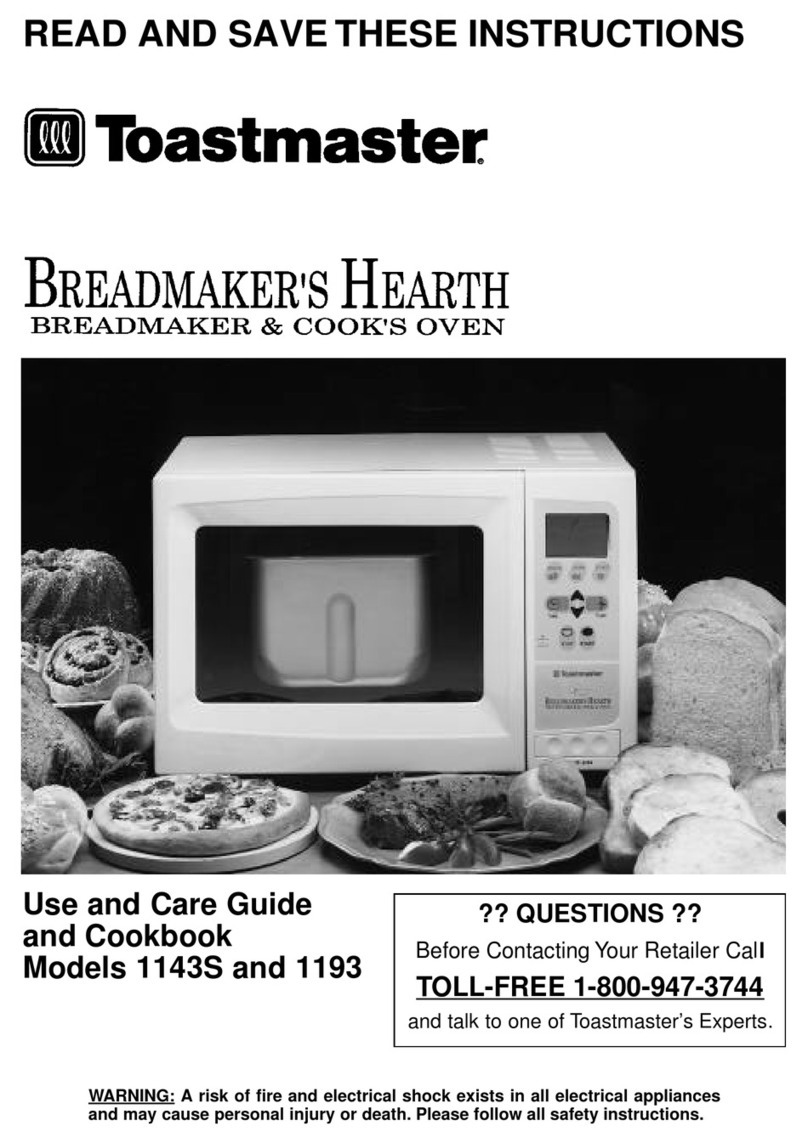
Toastmaster
Toastmaster Breadmaker's Hearth 1143S Use and care guide
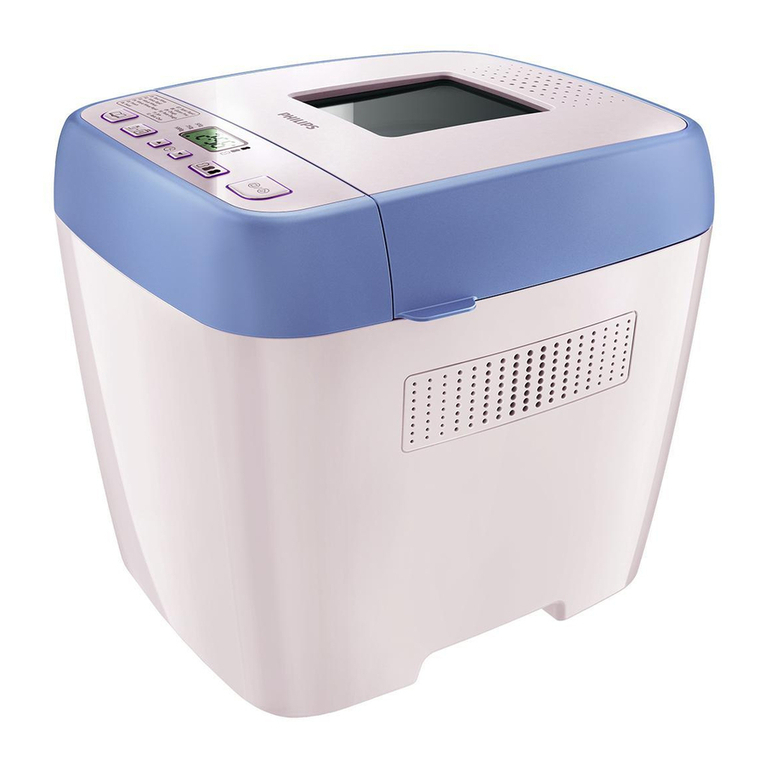
Philips
Philips HD9020 user manual
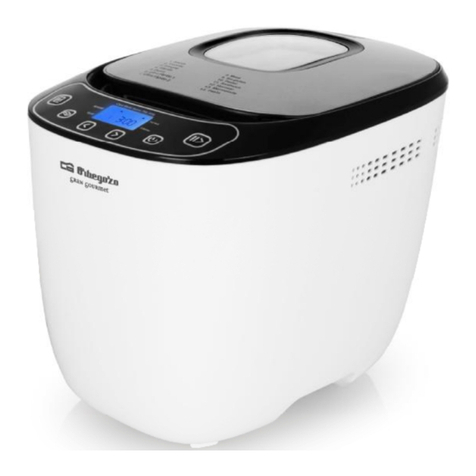
Orbegozo
Orbegozo MHP 3500 instruction manual

KitchenAid
KitchenAid KWB110 instructions

TEFAL
TEFAL PAIN ET TRESORS OF250 instructions
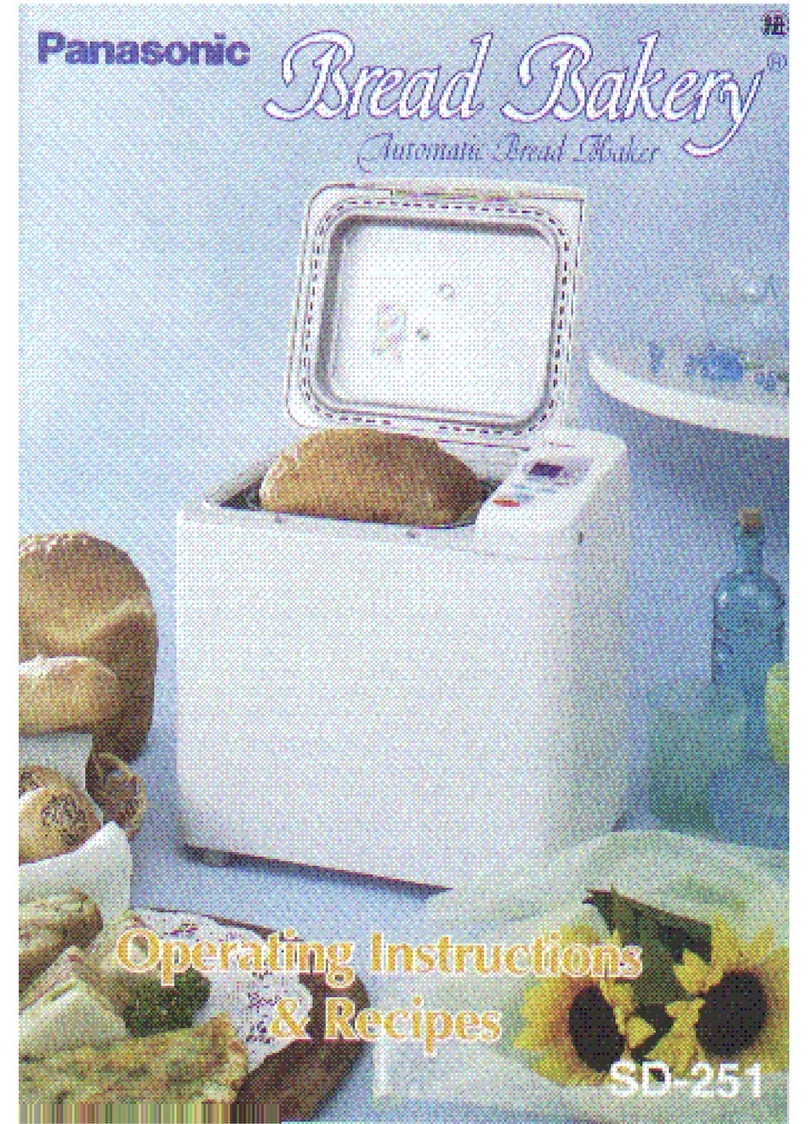
Panasonic
Panasonic Bread Bakery SD-251 Operating instructions & recipes
